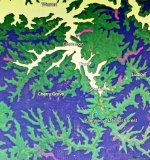Ladies and gentlemen, we have a BINGO. Thanks K-Bob for the heads up. I hadn't visited this forum for awhile.
Although there are numerous problem in that region, the lack of buffering is a big one. Even where there are no man made acid episodes (AMD from past drilling) there are natural ones. Even if there were no natural ones, precip is somewhat low in PH.
Because of the lack of buffering, you will never have many Class A streams in that region short of a massive airdrop of TUMs.
But those of us who have fished the lessor streams before the lists came out, don't know that they aren't worth fishing.
And here's a little trick if nobody else pointed it out. Most of the Allegheny Plateau was never glaciated. The glaciers sort of went around it. If you lay a glaciation map over the PFBC natural reproduction map, The better streams are likely in the overlap. Why, you ask? Although the native geology still sucks, the glaciers did drag some buffering with it. I don't know if the geology map showed that or not. I didn't look that close. I don't remember where I first read that. It might have been here and posted by an old fart like RleeP (no disrespect intended). When RLP pointed out the better streams are to the north, I already knew that. But a bell went off in my head. That is a long story made short.
If you are looking for where to fish, I'm not good at spoon feeding. I also haven't fished there in quite awhile. But in my experience almost all of the small blue lines have native brookies. I fished many of them before lists were published. The larger streams would also have natives if they weren't betting the shart stocked out of them. But alas, they are not Class A, are wide enough that I can't pee across them, and have access. ... so they get stocked.
Sorry about the crudeness in the last part, but when the heat index approaches 100 I stay inside and get cranky.






